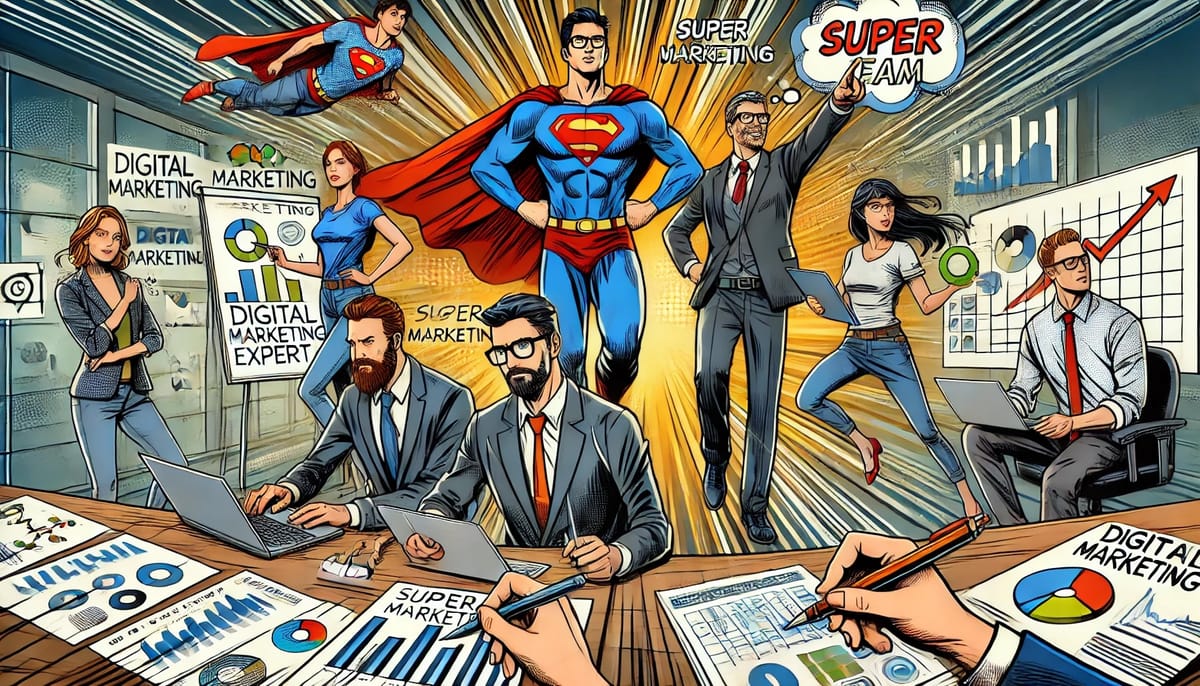Get In Gear: A Digital GTM Series (Episode II)

Before we dive in, I have a quick update: there will be no newsletter next week. Yours truly will be enjoying some family time in upstate New York on the shores of Chautauqua Lake. I have a Hype Cycle in the queue for next Tuesday, and then I’m off the grid (sorta 🤷🏼♂️) until the following week. Now, back to business.
I hope you’re ready for round two of our epic journey to operationalizing your marketing ideas. If you missed the first installment (and seriously, where were you?), we discussed the importance of turning those brilliant, world-changing ideas into operational realities. Think of it as turning your marketing vision board into a well-oiled machine.
Today, we’re diving into the first crucial step: designing your digital marketing team. Get ready to assemble your own Avengers, minus the spandex… unless that’s your thing. No judgment👍🏻.
The Role of a Well-Designed Team
Remember how we likened designing your team to casting a Hollywood blockbuster? Well, it’s time to pick your stars. A well-designed digital marketing team is the backbone of any successful strategy. It's not just about filling seats; it's important to align functions to the vision. You’ll need to invest in skills to execute the work collaboratively. It requires carefully balancing chemistry; unless you’re hiring robots, in which case, why are you contributing to the coming of SkyNet?? Are you crazy!? 🤖😵💫💀
A core principle of my philosophy for team-building is to let leaders lead. If you hire strong leadership for the functions within your Digital org, you need to trust them to build upon your foundation. The foundation is your vision, strategic goals, and their presence. Everything after that must be a co-sign from you, and they have to hold the reins. I can’t underscore this enough for all you would-be micromanagers out there. It ain’t cool. Stop it.
Let’s talk about functions. It may look and sound different within different companies, but the tenets are the same. Core functions are:
- Content: these are the strategists who partner with Creative and Brand management teams to turn ideas into work that can perform.
- Community: this function is responsible for having a finger on the pulse of what people are saying, feeling, and doing.
- Media: some companies call this Growth. Same difference. This team manages investments focused on increasing revenue opportunities.
- Measurement: these are your number-crunchers. They provide the analysis to support other functions being able to constantly iterate.
- Innovation: these are the dreamers who look ahead and help pull everyone forward into the future.
Some functions straddle between Digital and other company departments such as IT or E-Commerce. I won’t muddy the waters here, but as an aside — it’s important to build a collaborative spirit with those departments so that organization building can be thoughtful and comprehensive. When teams are built in silos, they become impressive in stature, but difficult to navigate. Think if all the major hotels in Vegas were one brand, but laid out as they are today. (Woof — just thinking about Vegas makes me shudder… 🙅🏼♂️.)
Structuring Your Team
The way you organize your team can make or break your success. It’s essential to root yourself in reality before you start cementing decisions. How is the entire company structured? What is the layout of the Marketing, IT, and Sales/E-Comm divisions? What are the guiding principles, or the OKRs, for the company? This information should guide how you draw up a blueprint for Digital to drive GTM success. Here are a few models to consider:
The “Traditional” Model
In this setup, team members specialize in one area and report to a department head. It’s straightforward but can be a bit rigid, like wearing a suit to a tech startup.
Pros:
- Clear roles and responsibilities
- Easy to manage
Cons:
- Can be siloed
- Less flexibility
This model works well in large, established companies, simply because this is how most of them are set up. However, there’s a big challenge here in terms of growth: both for individuals and the company. People can become locked into working in one function, which can stifle their opportunities and potentially the benefits unlocked by cross-pollinating people into different functions or even other departments.
The Hub-and-Spoke Model
Here, your core team (the hub) collaborates with specialists (the spokes) as needed. It’s like a well-coordinated heist movie, where each specialist brings unique skills to the table.
Pros:
- Flexibility
- Encourages collaboration
Cons:
- Can be complex to manage
- Requires strong communication
I employed a version of this model at Monster Energy. It works well when you have a defined management flow for work, and you require singular points of contact for each project/suite. The challenge is that it tilts leadership developments towards folks in the hub, and it can create unhealthy tension even within your own team. Spokes are important, too. Without them, wheels become unstable; they stop turning fast and straight.
The Agile Model
Software development teams typically embrace this model. It emphasizes small, cross-functional teams that work on specific projects. It’s fast, flexible, and perfect for dynamic environments. Think of it like having a small cadre of ninjas (which ten-year-old me says sounds awesome 🥷🏻).
Pros:
- High adaptability
- Promotes innovation
Cons:
- Requires a cultural shift
- Can be chaotic without strong leadership
Culture cannot be underscored enough in this model. If you try to institute an agile model within a legacy company, odds are you will meet a ton of resistance and confusion at the leadership level. My recommendation here would be to try to start w/ a hub-and-spoke model that slowly evolves towards being agile by designating single-threaded leaders for key projects. You can then provide tangible evidence to support a shift towards being more agile. You may even be able to bring other departments along collaboratively in that respect. Talk about true digital transformation! That’s the difference between Legos and Transformers.
The Impact of Remote Work & Curating Culture
Ah, remote work—the gift that keeps on giving (mostly). Thanks to the pandemic, remote work has become the norm. But managing a remote team comes with its own set of challenges. Here’s how to keep your remote team firing on all cylinders:
Communication is Key
Effective communication is the linchpin of a successful remote team. Use tools like Slack for quick chats, Zoom for face-to-face meetings, and project management software like Asana or Trello to keep everyone on the same page. Most of all — embrace asynchronous work. If people are working remotely, it’s because the company has established an understanding that there needs to be flexibility within folks’ daily lives. Harness it. This is tough for legacy companies, and it’s why team-building in that environment should include careful planning to evolve from a traditional model to something more agile.
Set Clear Expectations
Define roles, responsibilities, and deadlines clearly. Ambiguity is the enemy of productivity. Make sure everyone knows what’s expected of them and when. Likewise, perfection is the enemy of progress. Don’t let people sit in a spin cycle on work. Eighty percent of something new is more than you had before; celebrate the growth and iterate to get that last twenty percent.
Foster a Strong Team Culture
Just because you’re not in the same office doesn’t mean you can’t build a strong team culture. Virtual coffee breaks, team-building activities, and regular check-ins can help keep morale high and foster a sense of camaraderie. I learned this big time during COVID-19. It was something I had to emphasize as things returned to “normal” (OK, I kid we live in the Matrix, and the code’s breaking. It’s obvious. Sigh 😞…).
Designing your digital marketing team is about more than just filling positions. It’s about creating a cohesive unit that aligns with your strategic goals and can adapt to the ever-changing digital landscape. Whether you opt for a traditional model, a hub-and-spoke structure, or an agile approach, the key is to ensure clear communication, defined roles, and a strong team culture.
In our next installment, we’ll dive into making the right investment in technology and tools. Even the best team needs the proper gear to succeed, or you’re kind of like Batman without his gadgets—just a dude in a cape growling at everyone.
I hope all ye American readers have a happy and safe Independence Day 🇺🇸🎇loaded with good grilled food, cold adult beverages of your choice (mine will be a local IPA if you care 🍻) and excellent company. Over and out.
APPENDIX
Here is a team-building case study I find interesting. And you’re always welcome to email me for more discussion: kyle@theundercurrent.io. ✌🏻
Spotify: the streamer’s “Squad” model is a perfect example of the agile approach. Each squad is a small, cross-functional team focused on a specific aspect of the product. This structure allows Spotify to innovate quickly and adapt to changing market demands.




